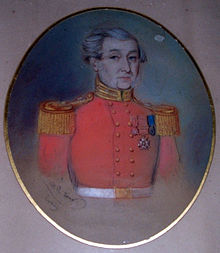John Vaughan Thompson
| John Vaughan Thompson | |
|---|---|

Doctor John Vaughan Thompson wearing the uniform of an officer in the Royal Army Medical Corps. Painting by D. Roux, London, circa August 1835.
|
|
| Born |
November 19, 1779 Brooklyn, New York, United States |
| Died | January 21, 1847 (aged 67) Sydney, Australia |
| Resting place | Headstone was at Glouster St., Cemetery NO. 451 later removed to La Perouse, Sydney. |
| Residence | 136 Liverpool Street, Sydney |
| Nationality | British |
| Alma mater | University of Edinburgh (1797–1798) |
| Known for | Pentacrinus Europæus, Crab metamorphosis, Barnacles, Polyzoa |
| Spouse |
|
| Children | 8 children |
John Vaughan Thompson FLS (November 19, 1779 – January 21, 1847) was a British military surgeon, marine biologist, zoologist, botanist, and published naturalist.
John Vaughan Thompson was born in British controlled Brooklyn on Long-Island in the Province of New York, North America on the 19 November 1779. The family returned to England sometime after the American victory in the American War of Independence.
He studied medicine at the University of Edinburgh (1797–1798), reading anatomy, surgery, midwifery and botany before joining the Army in 1799.
He grew up around Berwick-upon-Tweed where he wrote his first book A Catalogue of Plants Growing in the Vicinity of Berwick Upon Tweed which was published in 1807. In each of his military postings such as the West Indies and Guiana (1800–1809), Mauritius and Madagascar (1812–1816), he continued his natural history studies with two of his papers being read before the Linnean Society on London in 1807, the first On the genus Kaempferia in April 1807 and the second An Account of Some New Species of Piper in June, both of these were submitted on his behalf by Francis Mackenzie, 1st Baron Seaforth F.R.S and L.S.
In 1816, he was posted to Cork in Ireland as Surgeon to the forces and later as Deputy Inspector General of Hospitals. While in Cork he published several works including "Zoological researches and illustrations" (1828) which is listed as having been taken by Charles Darwin on his famous Second voyage of HMS Beagle
...
Wikipedia
